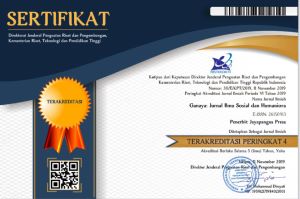Pengaruh Antara Tingkat Ketegangan Sosial Dengan Tingkat Risiko WBP Melakukan Perilaku Kekerasan Di Rutan Kelas IIB Purworejo
DOI:
https://doi.org/10.37329/ganaya.v6i1.1731Keywords:
Social Tension, Violent Behavior, Prisoners (WBP)Abstract
The violent behavior carried out by WBP while he was in prison is a thing that often occurs in prison. Where everyone who enters prison because of criminal cases will definitely experience a lot of pressure from within him or from outside himself. One of the triggering factors is the condition of peison which is over capacity. Violent behavior resulted in disturbances in security and order that disrupted the condition of prison. The purpose of this study was to find out the influence between the level of social tension and the level of risk of WBP committing violent behavior in prison class IIB Purworejo. This type of research is quantitative research. The population in this study is The Correctional Assisted person/prisoner prison class IIB Purworejo in november 2021 with a total of 180 people. The number of samples taken referred to Frankel and Wallen for this type of correlation study, which was as many as 50 respondents. Data collection was carried out by survey using questionnaires distributed to 50 WBP prison class IIB Purworejo as the object of research. Based on data and facts found by researchers at WBP prison class IIB Purworejo that the level of social tension affects the level of WBP risk of violent behavior. The results showed that the level of social tension of WBP Prison class IIB Purworejo was 70.7%. It can be concluded that the level of social tension that exists in the prison environment affects the violent behavior carried out by WBP in prison class IIB Purworejo.
References
Akemat, & Keliat. (2015). Model Praktik Keperawatan Profesional Jiwa. Jakarta: EGC. journal jiwa.
Arikunto, S. (2010). Prosedur Penelitian. Jakarta: Rineka Cipta.
Azwar, S. (2016). Metode Penelitian. Yogyakarta: Pustaka Belajar.
Bungin, H. M. B. (2013). Metodologi penelitian kuantitatif: Komunikasi, ekonomi, dan kebijakan publik serta ilmu-ilmu sosial lainnya (2nd ed.). Jakarta: Kencana Prenada Media Group.
Choi, J. (2019). Victimization, fear of crime, procedural injustice and inmate misconduct: An application of general strain theory in South Korea. International Journal of Law, Crime and Justice, 59(October), 100346.
Cresswell, J. W. (2017). Research Design Pendekatan Kualitatif, Kuantitatif, dan Mixed Edisi ketiga. Yogyakarta: Pustaka Belajar.
Creswell, J. W. (2012). Educational research: Planning, conducting, and evaluating quantitative and qualitative research. Educational Research, Vol. 4.
Direja, A. H. S. (2011). Buku Ajar Asuhan Keperawatan Jiwa (Edisi I). Yogyakarta: Nuha Medika.
Eitle, D., & Eitle, T. M. N. (2016). General Strain Theory and Delinquency: Extending a Popular Explanation to American Indian Youth. Youth and Society, 48(4), 470–495.
Fraenkel, Jack, R., & Norman, E. W. (2012). How to Design and Evaluate Research in Education 8th Edition. Boston: McGraw-Hill Higher Education.
Gao, Y., & Wong, D. S. W. (2018). Strains and Delinquency of Migrant Adolescents in China: An Investigation From the Perspective of General Strain Theory. Youth and Society, 50(4), 506–528.
M, R. N. L. (2021). Beredar Video Napi Lapas Jember Menganiaya Teman di Penjara, Begini Nasibnya Sekarang. Diambil 30 November 2021, dari merdeka.com website: https://www.merdeka.com/jatim/beredar-video-napi-lapas-jember-menganiaya-teman-di-penjara-begini-nasibnya-sekarang.html
Muhith, A. (2015). Pendidikan Keperawatan Jiwa: Teori dan Aplikasi. In Berita Ilmu Keperawatan.
Notoatmodjo, S. (2018). Metodologi Penelitian Kesehatan. Jakarta: Rineka Cipta.
Priyono. (2016). Metode Penelitian Kuantitatif (T. Chandra). Jawa Timur: Zifatama Publishing.
Sugiyono. (2012). Metode Penelitian Kuantitatif, Kualitatif, dan R&D. Bandung: Alfabeta.
Syahrum, & Salim. (2012). Metodologi Penelitian Kuantitatif (R. Ananda). Bandung: Citapustaka Media.
Yilmaz, I. (2015). General Strain Theory of Delinquency : The Developmental Process of Robert Agnew ’ s Works from a Historical Perspective. International Journal of Business and Social Science, 6(11), 168–178.
Yosef. (2009). Keperawatan Jiwa. In PT Refika Aditama (Revisi). Bandung: PT Refika Aditama.
Zhang, J., Liu, J., Wang, X., & Zou, A. (2018). Life Stress, Strain, and Deviance Across Schools: Testing the Contextual Version of General Strain Theory in China. International Journal of Offender Therapy and Comparative Criminology, 62(8), 2447–2460.
Downloads
Published
How to Cite
Issue
Section
License
Copyright (c) 2023 Aditya Bayu Krisna (Author)

This work is licensed under a Creative Commons Attribution-ShareAlike 4.0 International License.
An author who publishes in the Ganaya : Jurnal Ilmu Sosial dan Humaniora agrees to the following terms:
- Author retains the copyright and grants the journal the right of first publication of the work simultaneously licensed under the Creative Commons Attribution-ShareAlike 4.0 License that allows others to share the work with an acknowledgement of the work's authorship and initial publication in this journal
- Author is able to enter into separate, additional contractual arrangements for the non-exclusive distribution of the journal's published version of the work (e.g., post it to an institutional repository or publish it in a book) with the acknowledgement of its initial publication in this journal.
- Author is permitted and encouraged to post his/her work online (e.g., in institutional repositories or on their website) prior to and during the submission process, as it can lead to productive exchanges, as well as earlier and greater citation of the published work (See The Effect of Open Access).
Read more about the Creative Commons Attribution-ShareAlike 4.0 Licence here: https://creativecommons.org/licenses/by-sa/4.0/.








